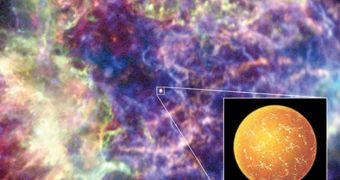According to the latest investigations of young neutron stars, it would appear that the only way to account for the significant temperature changes they are undergoing is to accept that they have liquid cores. Experts believe that the objects' interior may be made up of a state of matter called superfluid.
These cosmic structures are the second-most dense in the entire Universe. A single teaspoon of matter from a neutron star can weigh in excess of 100 trillion tons, or heavier than an entire Earth mountain.
The only thing more dense is a black hole, which is theoretically an object of infinite density. They are so massive that they warp spacetime around them, trapping even light particles inside.
While observing the remains of a star that went supernova far away from our planet, two separate science teams discovered that the only way to explain the way the new neutron star was evolving was to consider that a frictionless superfluid existed at its core.
“This the first direct evidence for superfluidity in neutron stars,” explains the coauthor of one of the new research papers, University of Southampton astrophysicist Wynn Ho.
Details of his work will appear in an upcoming issue of the esteemed journal Monthly Notices of the Royal Astronomical Society. The other team will publish its results in a future issue of the scientific journal Physical Review Letters.
The object the two teams analyzed is located in the constellation Cassiopeia, some 11,000 light-years away from our solar system. The star that generated the young neutron star blew up in a supernova event some 300 years ago.
The first observations of the ensuing neutron star were made in 1999, using the NASA Chandra X-Ray Observatory, Science News reports. At the time, the surface of the star has a temperature of 2 million degrees. Since then, in about a decade, that level dropped by 4 percent.
“This was the first time anyone found a young neutron star clearly changing temperature,” explains the Canadian physicist who first reported on this finding last year. Craig Heinke, who is an astrophysicist at the University of Alberta in Edmonton, Canada, published the data in Astrophysical Journal Letters.
“The star should keep cooling off at the same rate for a few more decades,” explains scientist Dany Page, who is based at the National Autonomous University of Mexico, in Mexico City.

 14 DAY TRIAL //
14 DAY TRIAL //